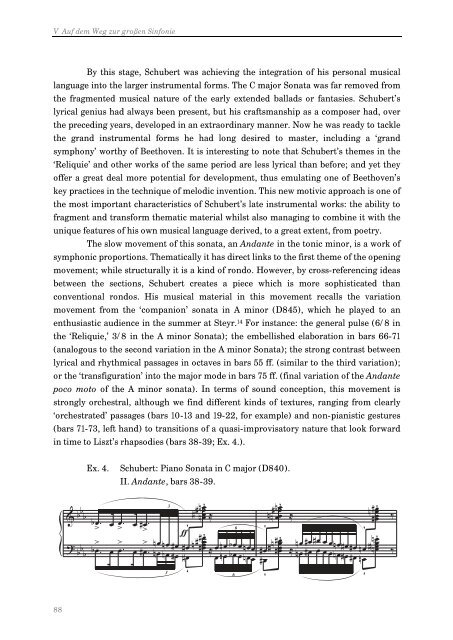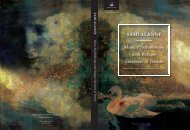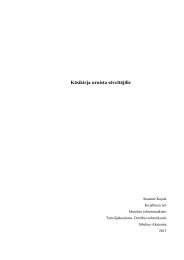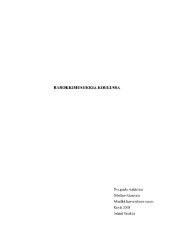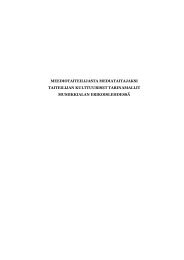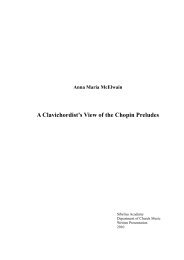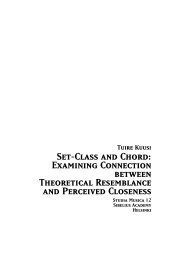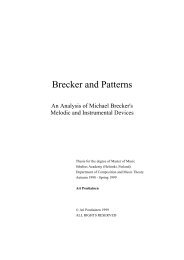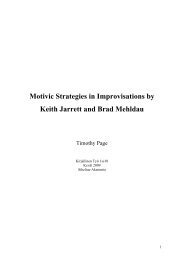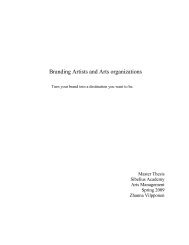The Unfinished Piano Sonatas of Franz Schubert Javier ... - Ethesis
The Unfinished Piano Sonatas of Franz Schubert Javier ... - Ethesis
The Unfinished Piano Sonatas of Franz Schubert Javier ... - Ethesis
You also want an ePaper? Increase the reach of your titles
YUMPU automatically turns print PDFs into web optimized ePapers that Google loves.
V Auf dem Weg zur großen Sinfonie<br />
By this stage, <strong>Schubert</strong> was achieving the integration <strong>of</strong> his personal musical<br />
language into the larger instrumental forms. <strong>The</strong> C major Sonata was far removed from<br />
the fragmented musical nature <strong>of</strong> the early extended ballads or fantasies. <strong>Schubert</strong>’s<br />
lyrical genius had always been present, but his craftsmanship as a composer had, over<br />
the preceding years, developed in an extraordinary manner. Now he was ready to tackle<br />
the grand instrumental forms he had long desired to master, including a ‘grand<br />
symphony’ worthy <strong>of</strong> Beethoven. It is interesting to note that <strong>Schubert</strong>’s themes in the<br />
‘Reliquie’ and other works <strong>of</strong> the same period are less lyrical than before; and yet they<br />
<strong>of</strong>fer a great deal more potential for development, thus emulating one <strong>of</strong> Beethoven’s<br />
key practices in the technique <strong>of</strong> melodic invention. This new motivic approach is one <strong>of</strong><br />
the most important characteristics <strong>of</strong> <strong>Schubert</strong>’s late instrumental works: the ability to<br />
fragment and transform thematic material whilst also managing to combine it with the<br />
unique features <strong>of</strong> his own musical language derived, to a great extent, from poetry.<br />
<strong>The</strong> slow movement <strong>of</strong> this sonata, an Andante in the tonic minor, is a work <strong>of</strong><br />
symphonic proportions. <strong>The</strong>matically it has direct links to the first theme <strong>of</strong> the opening<br />
movement; while structurally it is a kind <strong>of</strong> rondo. However, by cross-referencing ideas<br />
between the sections, <strong>Schubert</strong> creates a piece which is more sophisticated than<br />
conventional rondos. His musical material in this movement recalls the variation<br />
movement from the ‘companion’ sonata in A minor (D845), which he played to an<br />
enthusiastic audience in the summer at Steyr. 14 For instance: the general pulse (6/8 in<br />
the ‘Reliquie,’ 3/8 in the A minor Sonata); the embellished elaboration in bars 66-71<br />
(analogous to the second variation in the A minor Sonata); the strong contrast between<br />
lyrical and rhythmical passages in octaves in bars 55 ff. (similar to the third variation);<br />
or the ‘transfiguration’ into the major mode in bars 75 ff. (final variation <strong>of</strong> the Andante<br />
poco moto <strong>of</strong> the A minor sonata). In terms <strong>of</strong> sound conception, this movement is<br />
strongly orchestral, although we find different kinds <strong>of</strong> textures, ranging from clearly<br />
‘orchestrated’ passages (bars 10-13 and 19-22, for example) and non-pianistic gestures<br />
(bars 71-73, left hand) to transitions <strong>of</strong> a quasi-improvisatory nature that look forward<br />
in time to Liszt’s rhapsodies (bars 38-39; Ex. 4.).<br />
88<br />
Ex. 4. <strong>Schubert</strong>: <strong>Piano</strong> Sonata in C major (D840).<br />
II. Andante, bars 38-39.<br />
& b<br />
?<br />
b b<br />
b b b œ<br />
><br />
. œ œ<br />
><br />
. œ # œ .<br />
><br />
b b œ .<br />
><br />
œ<br />
><br />
œ . œ # œ .<br />
><br />
# n ´ 3<br />
# n œ ≈<br />
´<br />
6<br />
ƒ # ´<br />
n œ n œ # œ # œ n #<br />
œ n œ b œ œ n œ<br />
n œ<br />
# œ<br />
œ<br />
n œ<br />
≈<br />
# œ # œ<br />
œ n œ b œ œ n œ œ<br />
ÿ<br />
3<br />
6<br />
œ<br />
œœ ´<br />
# œ<br />
n<br />
n #<br />
´<br />
n<br />
n # ´<br />
# # œ<br />
# œ<br />
ÿ<br />
≈<br />
n # ´<br />
# œ<br />
´<br />
n œ # œ # œ œ œ n œ<br />
n<br />
≈ # œ # œ<br />
n œ # œ œ œ œ n œ # n œ<br />
n œ # œ # œ n œ<br />
ÿ<br />
´<br />
‰<br />
‰


